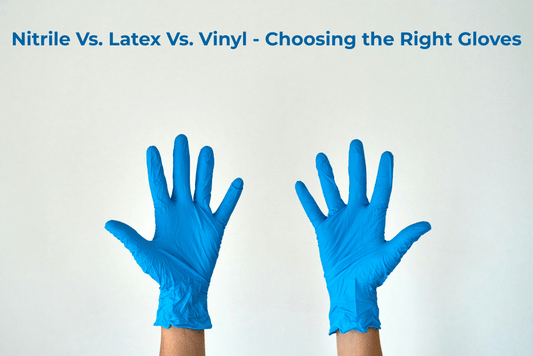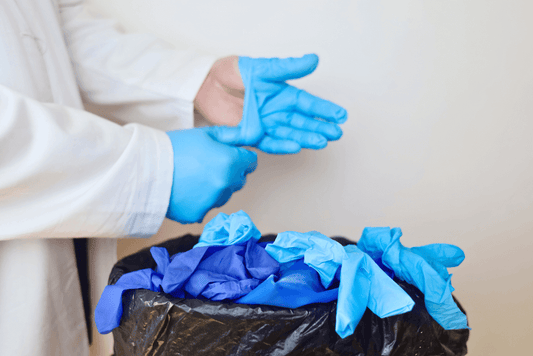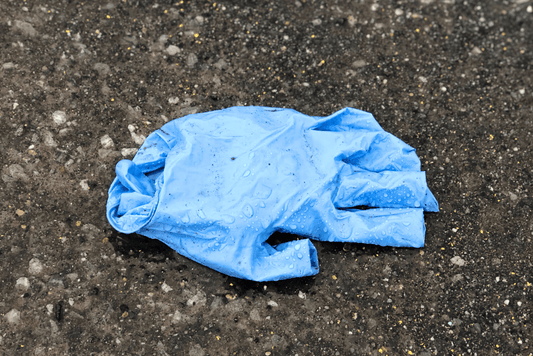Biodegradable vs. Traditional Gloves - Real Shelf Life (And the Landfill Life)
The use of disposable gloves has expanded rapidly across healthcare, food service, manufacturing, and personal use. The question of durability and longevity, specifically, how long gloves can be stored before they degrade, is increasingly relevant. Traditional disposable gloves, such as nitrile, latex, and vinyl, have defined shelf lives determined by their material properties. Biodegradable gloves, which are developed with environmental responsibility in mind, introduce new considerations.
This article outlines how shelf life differs between biodegradable and conventional gloves, the factors influencing longevity, the challenges of storage, and the broader implications for businesses and individuals who rely on disposable protective equipment.
Understanding Shelf Life in Disposable Gloves
Shelf life refers to the period during which gloves maintain their protective qualities, elasticity, and usability. It is not the same as physical endurance during wear; instead, it concerns how long gloves can be stored before losing functionality.
All gloves, regardless of material, begin to degrade over time. Heat, light, humidity, and exposure to oxygen can alter their molecular structure. Even sealed boxes are not immune, as the passage of time gradually affects the polymer chains that make up the glove.
For manufacturers, assigning a shelf life helps provide users with a reliable guideline for safe use. For buyers and organisations, respecting these timelines reduces the risk of stockpiling gloves that later fail when needed.
Traditional Gloves and Their Expected Longevity
Latex Gloves
Latex is a natural material derived from rubber trees. Its elasticity and barrier properties have made it a common choice. Typically, latex gloves last about three years in storage under proper conditions. After that period, they begin to lose stretch and may become brittle.
Nitrile Gloves
Nitrile, a synthetic polymer, is valued for its chemical resistance and durability. The shelf life of nitrile gloves is generally five years, sometimes slightly longer if stored carefully. Their stability in varying conditions makes them the preferred option for many industries requiring reliability.
Vinyl Gloves
Vinyl gloves, produced from polyvinyl chloride (PVC), tend to have the shortest shelf life among traditional options. On average, they last around three years. Over time, vinyl stiffens and loses flexibility, leading to tearing during use.
Biodegradable Gloves: A New Category
Biodegradable gloves are manufactured using modified nitrile or other formulations designed to break down more rapidly in specific disposal environments, such as landfills. Additives allow microorganisms to consume the material, reducing long-term waste.
Because of these modifications, questions arise about how storage life compares to conventional gloves. Many assume that quicker decomposition in landfill conditions also means reduced shelf life on the shelf. This assumption is only partly correct.
Manufacturers design biodegradable gloves to maintain stability during normal storage while allowing breakdown once exposed to microbial activity. Shelf life often mirrors that of traditional nitrile, up to five years under controlled conditions. However, there can be slight variations depending on the exact formulation.
Factors That Influence Shelf Life
Temperature
Heat is one of the strongest influences on glove stability. High temperatures accelerate molecular breakdown. Storing boxes near machinery, windows, or radiators shortens shelf life. Cool, dry storage areas extend it.
Humidity
Moisture promotes material changes in both natural and synthetic gloves. Latex is especially sensitive to damp conditions. Biodegradable nitrile gloves also respond to humidity, although sealed packaging provides some protection.
Light Exposure
Ultraviolet (UV) light from direct sun can weaken glove polymers. Boxes should remain in opaque cartons or cabinets to limit light penetration.
Packaging
Gloves kept in sealed packaging retain quality longer than those exposed to air. Once opened, a box should ideally be used within a reasonable period rather than left for years.
Additives in Biodegradable Gloves
The inclusion of biodegradable additives slightly alters the chemical structure of nitrile. These additives are stable in regular storage conditions but become active when exposed to the microbial activity of disposal environments. While shelf life remains similar to traditional nitrile, there may be small differences depending on the formulation used by the manufacturer.
Comparing Biodegradable and Traditional Gloves
At first glance, biodegradable gloves and traditional nitrile gloves offer similar shelf lives. Both are estimated to last up to five years if stored correctly. Latex and vinyl, however, last around three years.
The distinction lies less in longevity and more in end-of-life pathways. Traditional gloves persist in landfills for decades, while biodegradable gloves are engineered to degrade faster under those conditions. This environmental difference does not necessarily compromise storage stability, but users must still observe storage best practices.
Storage Best Practices for Maximizing Shelf Life
-
Keep gloves in a cool, dry location; ideal storage is typically between 15°C and 25°C.
-
Avoid direct sunlight and fluorescent lighting, store cartons away from windows and light sources.
-
Maintain gloves in their original packaging until use. This prevents contamination and exposure to air.
-
Organize stock by purchase date, and use older supplies before newer ones to minimize expired products.
-
Do not store near chemicals or solvents that may accelerate degradation.
Following these steps helps preserve both biodegradable and traditional gloves within their expected shelf life.
The Role of Expiry Dates
Most glove boxes carry an expiration date printed by the manufacturer. This is based on material testing under controlled conditions. While gloves may still appear functional after that date, their protective integrity cannot be guaranteed.
In regulated industries such as healthcare, expired gloves are considered unusable, regardless of visual condition. For food handling or light tasks, some individuals may still use them, but this is not recommended. For biodegradable gloves, respecting expiration dates is equally necessary to maintain safety standards.
Misconceptions About Biodegradable Gloves
A frequent concern is that biodegradable gloves will begin degrading in storage well before use. In reality, these gloves are formulated to remain stable until disposal. The breakdown process activates only in environments rich with microbes, such as landfills or composting facilities.
Another misconception is that biodegradable gloves always have shorter shelf lives. While certain formulations may have slight differences, most leading biodegradable nitrile gloves match the five-year shelf life of conventional nitrile.
Industrial Considerations
Large-Scale Procurement
Organisations purchasing gloves in bulk must consider shelf life to avoid waste. For hospitals, laboratories, and food companies, rotating stock is critical. Storing biodegradable gloves requires the same discipline as conventional nitrile.
Regulatory Compliance
Expiry dates play a role in regulatory inspections. Healthcare facilities, for instance, are not permitted to use expired gloves, regardless of type. This places equal responsibility on biodegradable and traditional gloves to be tracked carefully.
Waste Management
Biodegradable gloves add value at the disposal stage, but only if they are stored properly beforehand. If degradation occurs prematurely due to poor storage, they may lose effectiveness during use.
Consumer-Level Decisions
For individuals purchasing gloves for household use, gardening, cleaning, or first aid, shelf life matters too. Buying in small quantities avoids the risk of long storage periods. Biodegradable options offer environmental benefits without sacrificing reliability, provided they are used within recommended timelines.
Consumers should also check packaging for clear labeling, as different brands may specify slightly different durations.
The Environmental Angle
Traditional gloves create persistent waste. Landfills across the globe are filled with synthetic gloves that take decades or longer to degrade. Biodegradable gloves aim to reduce this burden. However, environmental benefit is maximized only if gloves remain usable through their shelf life. Premature failure wastes resources and undermines the goal.
The balance between storage longevity and biodegradability represents a technological achievement: gloves that remain intact for years but still break down faster when discarded.
Shelf Life Challenges in Hot Climates
Regions with consistently high temperatures face specific challenges. Warehouses without climate control may see shortened shelf life for both biodegradable and traditional gloves. In such cases, rapid turnover of stock is the best strategy.
Organisations in warmer climates often schedule more frequent deliveries rather than stockpiling large volumes. This approach helps reduce the risk of product loss due to expired supplies.
Ongoing Research and Development
The glove industry continues to study material science with two goals: extending shelf life under storage conditions and accelerating breakdown at disposal. Manufacturers of biodegradable gloves are working to refine additives so that they remain fully stable during storage yet degrade more predictably in landfills.
Traditional glove producers are also improving stabilizers to help maintain integrity in storage. Both directions highlight the intersection of safety, performance, and environmental responsibility.
What Users Can Do
-
Purchase the right quantity. Avoid stockpiling beyond what will be used in three to five years.
-
Follow storage guidelines. Temperature and humidity control make a measurable difference.
-
Rotate stock. Use the oldest supplies first to minimize expiry losses.
-
Check labels. Respect manufacturer expiration dates.
-
Choose biodegradable options. They provide environmental benefits without compromising reliability, provided storage conditions are respected.
The Future of Glove Shelf Life
Advances in materials are likely to push shelf lives further, especially for biodegradable gloves. Research focuses on striking the right balance between long-term storage stability and rapid environmental breakdown after disposal.
For now, biodegradable gloves generally match the shelf life of nitrile gloves, while latex and vinyl remain slightly shorter. As innovation progresses, broader adoption of biodegradable gloves is expected, supported by industry demand and regulatory encouragement for sustainable practices.
Understanding shelf life helps reduce waste, maintain safety standards, and support environmental goals.
The shelf life of biodegradable gloves compared to traditional ones shows more similarities than differences. With proper storage, both categories remain reliable for years. The true advantage of biodegradable gloves lies in what happens after disposal. By combining shelf stability with improved environmental outcomes, they provide a pathway toward more responsible glove use without sacrificing practical reliability.








